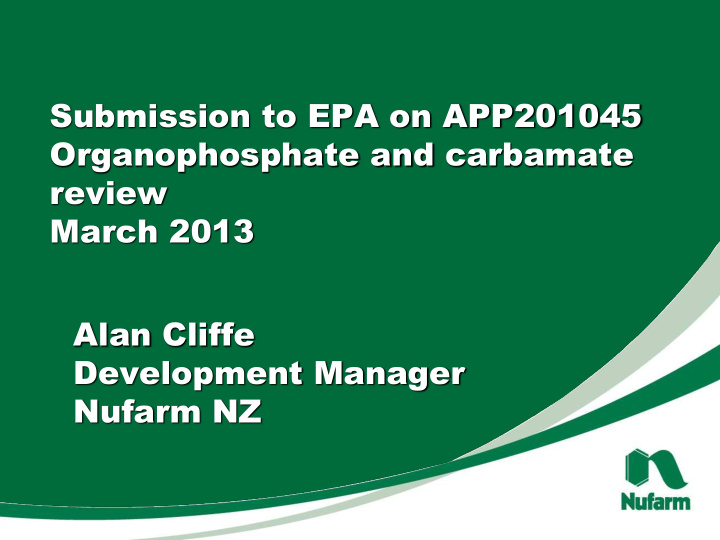



Submission to EPA on APP201045 Organophosphate and carbamate review March 2013 Alan Cliffe Development Manager Nufarm NZ
Background My history BSc Massey 1974 37 years with Nufarm in R&D and Registration Nufarm Limited Originated with NZ Farmers Fertilizer Multinational manufacturer and marketer of agricultural chemicals $A 2 billion turnover in 2012 Nufarm NZ is a subsidiary of Nufarm Limited
History Nufarm NZ markets: chlorpyrifos, diazinon, fenitrothion, phorate, pirimiphos-methyl, terbufos Submission in Nov 2011 fenitrothion ...not supported diazinon ...strongly supported chlorpyrifos....strongly supported phorate ...not supported while diazinon option pirimiphos-methyl...strongly supported terbufos...not supported while diazinon option Submission in Jan 2013 pirimiphos-methyl ...focused on the economic benefits in fodder crops
General comments Consultation process January deadline for submissions was too short as it included a significant holiday period Appreciation that after consideration of the economic benefits of pirimiphos-methyl, the review committee now recommends that outdoor uses be retained Concern at some of the controls being proposed and the apparent naivety of EPA when it comes to farming practice Concern that EPA may consider making label statements mandatory Concern that EPA is considering mandating parts of NZ Standard 8409 Management Of Agrichemicals (which are deliberately only recommendations in the standard)
Proposed controls that we agree to (specifically regarding pirimiphos-methyl) R-3 Max application rate and max no applications per year EPA needs to consider whether the control should be on “applications per year” or “applications per crop cycle” R-7 Prohibit indoor handgun application R-8 label identification as an organophosphate Can be included as the chemical grouping in a “Resistance Management “ statement as per the AGCARM labelling guide (pg 74) R-9 Bee warning on label – Already present R-10 PPE required with minimum standards – Already present R-11 Notification of neighbours – A requirement of regional air plans. EPA controls should align with Regional Council Air Plans
Proposed controls that we agree to (specifically regarding pirimiphos-methyl) R-12 Restricted Entry Intervals 12 hours is acceptable for pirimiphos-methyl R-13 Approved Handler for all uses Currently applied to ‘wide dispersive use” or a contractor. Knapsack use would now be included NOTE :EPA should make the requirements for Approved Handler, Tracking, and Record Keeping part of the label . The AGCARM labelling guide recommends this (pg 55) R-14 Signage following indoor use with unrestricted access R-16 Authorised persons ( Biosecurity)
Proposed controls that we object to X R-4 Mandatory Buffer zones
Buffer Zones A buffer zone is the downwind distance between the edge of the spray and a sensitive area such as a drain, or roadway EPA propose to mandate buffer zones a boom sprayer, no shelter belt buffer zone 10m for ground application 300m for aerial application Should be a recommendation only not a legal requirement NZS8409:2004 - G6.1 Buffer Zones (pg102) “ It is vital that the guidelines given below are regarded as that – guidelines, which represent the best estimate for three typical application types”
Buffer zones EPA position (APP201045 pg 112 ) “ Treatment of crops within a buffer zone can be achieved by carrying out the treatment of those areas when the wind is coming from a different direction and require a different buffer zone to be established” This is a very impractical response
Buffer zones “Downwind” is often at an angle to the boundary, taking out two boundaries Spraying the buffer zone at a later date is totally impractical: Spray contractors do not have time to return to a farm to complete a spray job - cost would be prohibitive Spraying relies on weather windows of fine weather and light winds. Adverse weather may prevent the unsprayed buffer zone being treated for several days or longer This may be Outside the suitable crop growth stage Weeds may have grown past their susceptible growth stage. Pest or disease infestations may have increased and started to re-infect the previously treated area – requiring additional spraying in the previously treated area
Buffer zones If a10m buffer zone from an adjacent drain is applied to this paddock, which is typical of much of the Waikato and Hauraki Plains, 18% could not be sprayed. This also applies to the maize on the LHS, which could just have easily have been a brassica crop. The whole farm would be affected. None of the farm could be sprayed by air if a 300m buffer zone was applied. 10m 10m Paddock width 55m
Spraying Frequency EPA have indicated that label recommendations on the frequency of applications could become a mandated control “ The main way for the EPA to minimise risk is to minimise exposure. As such EPA staff recommend controls such as application rates, frequencies and REI’s” ....... APP201045 Pg 115 Label frequency recommendations are guidelines eg “Apply every 10 to 14 days” Application frequency varies with pest or disease pressure, weather, spraying conditions etc Users need flexibility to manage their crop and their business An application made at 15 days rather than 14 days after the previous application (eg because of bad weather) does not impact on EPA’s risk assessment in any way EPA was advised that users would ignore any control on spray frequency “ If this is the case then a user will be in breach of the HSNO Act controls and could be investigated by an enforcement agency”. APP201045 Pg115 EPA’s position can only be described as officious
Label changes We agree with the proposed 2 years for label changes EPA have agreed that changes do not have to be made to “product on farm” EPA have not commented on whether “stock in trade” will require relabeling Relabeling of stock in trade should not be required as it would be a logistical nightmare to recall, transport and redistribute. Amended labels should only be required on new stock leaving the manufacturing site
Thank you for the opportunity to make a submission Do you have any questions?
Recommend
More recommend